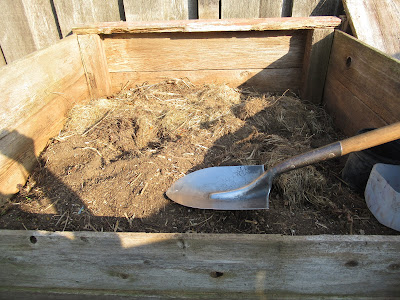My garlic is planted in next year’s designated onion bed. The onions follow the greenhouse and the garlic shouldn’t be planted until the greenhouse is moved. I’d rather the garlic didn’t have a warmer environment inside the greenhouse when starting out – it shouldn’t have too much of a start on growth but rather something slow and regulated to the actual local climate.
My son TOG has advised against planting garlic in September here in the Fraser Valley since it might get too far ahead before the cold snaps and heavy frosts come in the winter. So early November garlic planting after the greenhouse is moved works for me.
In the kitchen we can use 15 bulbs with about 6 cloves in each bulb for a winter supply. Plus we need 3 more bulbs for planting 18 cloves for the next year’s crop.
My spacing is the same as my onions: rows one foot apart across the four foot wide bed, with plants 8 inches apart in the rows. They would do just as well with 10 inches equidistant but I find the 12 inches between rows gives me easier access for that final weed cleaning before mulching with old, shredded leaves in May.
I use my row marker for laying out the spots then trowel a 3 inch deep trench, about 6 inches wide. Totaling up 3 rows across the bed with 6 inches on each end makes up 3 linear feet of bed = 12 square feet. Applying Rock Phosphate (or bone meal) at a generous 4 lbs per 100 square feet for bulb plants gives us half a pound for our 18 cloves. Alas, I did my math wrong in the garden and wound up using a full pound. We’ll see how that works out.
Last March I acquired a full cubic yard (27 cubic feet) of ‘hot’ fresh, free-run, organic fed, layer’s chicken gold (manure) from my brother-in-law’s operation. He had turned it twice and when I got it home I turned it every 2 or 3 days another 8 times. It heated up really well but still smelled hot. So I let it rest, sheltered all summer and hopefully it should be ready for next year’s growing season.
I grabbed 2 gallons of that fine stuff, smelling much more earthy now, and applied it to the garlic row trenches along with the rock phosphate.
This I stirred in with my small single-handed cultivator. (I once had a vintage, long, thin, ash handled, four-tight-curved-tined cultivator that was a wonder to use. I do believe it walked away. Always lock up your tools.) Without this fine Chicken, I'd normally use one half pound or a bit more of Soya Meal. (4 or 5 lbs per 100 square feet.) I feel Soya is longer lasting or slower releasing than Alfalfa meal.
After blending the mix in the trench bottom, I placed my biggest garlic cloves into the fluffed up soil with the pointy ends pointing up and covered with about 3 inches of soil. I like Russian Red hard necked garlic. I raked the bed flat and smooth and covered with the obligatory fence mesh to deter cats.
I prefer not to cover the bed with a mulch for the winter, I’ve had too many pale blanched tips trying to find sunlight in January and February and once they become rudely uncovered they freeze more readily and I think that sets them back. I tend to think it’s better to let the soil stay cooler and they can harden properly as they emerge. I might throw some leaves over the plot under the fence wire if there’s to be a nasty week-long cold snap and then pull it off as soon as the rains return but the regular modest frosts here shouldn’t be a problem.
The next chore won’t happen until mid-March when I’ll top dress with some more chicken gold. Actually, this time it will be Chicken Gravy from my own hens. I can give out my gravy recipe then.
I re-read parts of our garlic growing resource book: “Growing Great Garlic” by Ron L. Engeland. His advice on garlic depth (one inch deep) and mulch (6 inches of grass clippings after planting) are good but perhaps better for his location. He farms in North Central Washington due south of Osoyoos, BC and has a harsher winter than us plus he only gets 16 inches of rain per year.
I get 63 inches of rainfall and don’t like to mulch my garlic and onions until the soil has really warmed up in early May. Before that time lack of soil moisture is never a problem and mulching in our wet spring could keep the soil too cold.
Engeland advises that planting depth and mulch have trade offs and should be fine-tuned. I’m pretty safe with my procedures, however he has me wondering if I was careful enough in separating the cloves – I may have planted some that became stemless (that’s a part on the bottom among the root sources). I may have to peek at the bulbs in mid-winter looking for growth to see if I got it wrong.
Happy Gardening.











